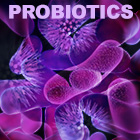 Acidophilus is the term generally applied to the body’s resident one-celled, lactic acid-producing bacteria. Lactic acid bacteria are also known as “friendly flora” or probiotics (meaning “in favor of life”). These bacteria are essential tenants of the digestive and vaginal tracts promoting mucosal immunity and better nutrition.
Acidophilus is the term generally applied to the body’s resident one-celled, lactic acid-producing bacteria. Lactic acid bacteria are also known as “friendly flora” or probiotics (meaning “in favor of life”). These bacteria are essential tenants of the digestive and vaginal tracts promoting mucosal immunity and better nutrition.
Probiotics are defined as “a live microbial supplement which beneficially affects the host animal by improving its intestinal microbial balance” (Fuller, J App Bacteriology 66: 365–78, 1989). Friendly flora produce lactic acid and other compounds, including natural antibiotics (also called bacteriocins). They help protect the intestinal and vaginal mucosal tissues from harmful fungus (e.g., yeasts) and displace putrefactive and pathogenic bacteria that can cause diarrhea, vaginitis, and other conditions associated with dysbiosis or flora imbalance.
While some species or strains (subspecies) of friendly flora “implant,” i.e., adhere to the intestinal and vaginal mucosa, others are transient. Transient flora may reproduce while moving through the large intestines, yet do not implant and so they exit via the stool.
Multiple Probiotic Species in PolyDophilus
There are over 400 different probiotic species, and thousands of strains of organisms inhabiting the human gut (Moore and Holdman. App Microbiology 27: 961–79, 1974). The intestines harbor a complex ecology of probiotic-friendly flora (the lactic acid-producing bacteria) along with not so friendly coliforms, bactericides, yeasts, pathogens, etc.
Given this complex environment, PolyDophilus was formulated with guidance from microbiologist Edward Brochu, PhD, to provide representation from the two most important of the four genera (groups) of lactic acid-producing bacteria. The four genera are: 1) Lactobacilli, 2) Bifidobacteria, 3) group N Streptococci and 4) certain group D Streptococci (also called Enterococci). Bifidobacteria are the most numerous in overall count in the large intestine, while Lactobacilli and Streptococci are more numerous in the small intestines.
1) Lactobacilli: This genus includes species such as L. acidophilus*, L. rhamnosus*, L. plantarum*, L. casei*, L. bulgaricus and L. lactis. “L” stands for Lactobacillus, the genus name. L. bulgaricus (found in yogurt) along with L. lactis, are transient, non-implanting flora, while certain strains of L. acidophilus, L. rhamnosus, L. plantarum, and L. casei can implant.
2) Bifidobacteria: Over 30 bifidal species have been isolated. The species most often found in humans are B. longum*, B. breve*, B. bifidum*, B. adolescentis and B. infantis. They are strictly anaerobic (and therefore fragile) and require more complex sugars such as lactose and dextrins or fructooligosaccharides (FOS) to grow and multiply.
3) Group N Streptococci: Also called “lactococci,” this genus includes S. lactis and S. thermophilus. These species are commonly used in the fermentation of yogurt (S. thermophilus) and cheeses. They do not implant, but are found in the intestinal tract as long as they are ingested.
4) Group D Streptococci: This is a Streptococci subgroup known as Enterococci. E. faecium (previously named Streptococcus faecium) is a normal inhabitant of the human gut. It is found throughout nature and often in foods. E. faecium/S. faecium is prolific and produces high levels of lactic acid. It is, however, controversial and no longer favored for human supplementation.
Each probiotic species tends to colonize its own separate regional ecological niche in the intestines. These niches reflect differences in pH, nutrient availability, aeration (oxygen level), peristalsis (wave-like intestinal motions that move food through), sloughing of intestinal cells, and secretion of mucia (a mucous-like protective barrier from the large intestine’s goblet cells).
It may be seen that with respect to probiotics, your intestines support a complete ecosystem of lactobacteria. Keeping gut populations of probiotics healthy and strong is a major key to good health.
* strains included in PolyDophilus
NEXT: Part 2

